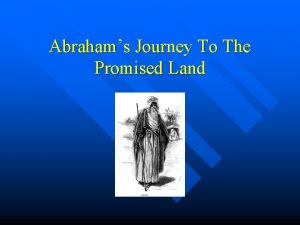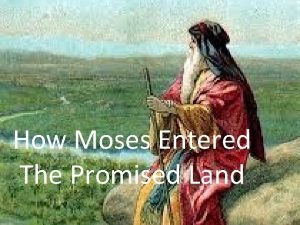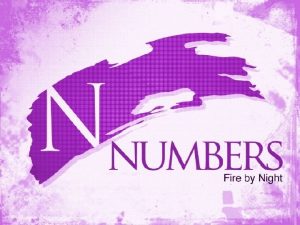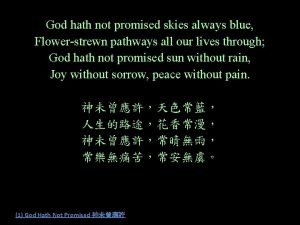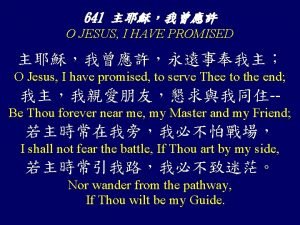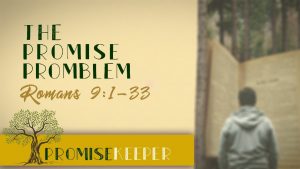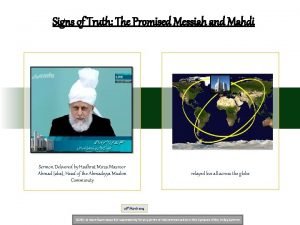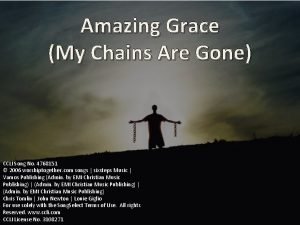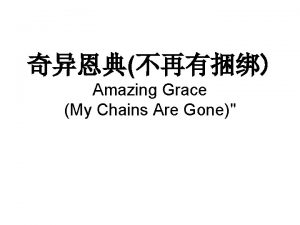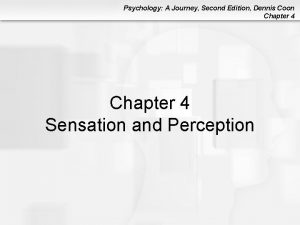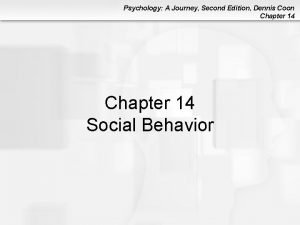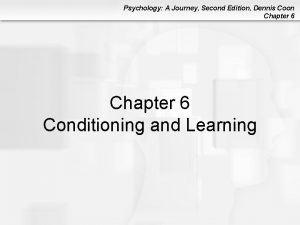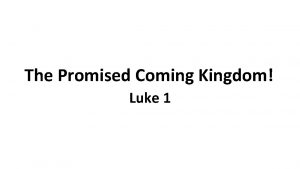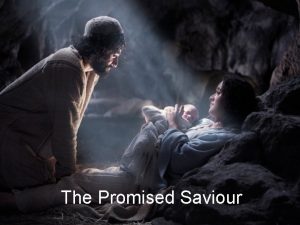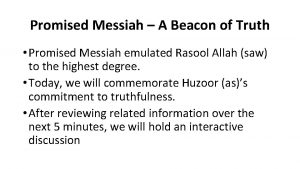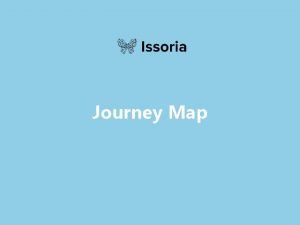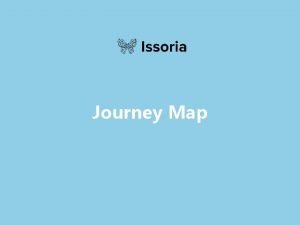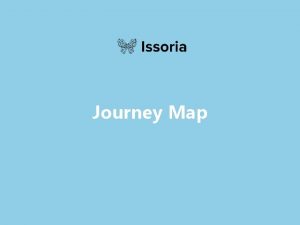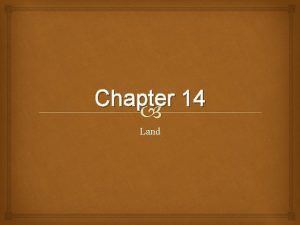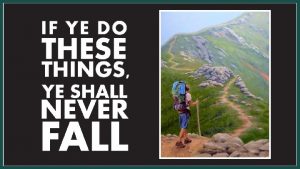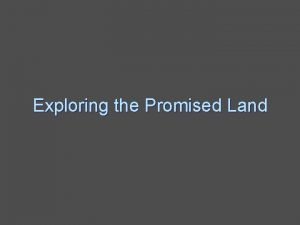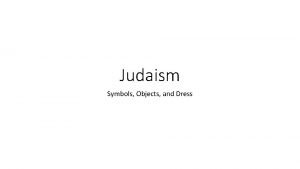CHAPTER FOUR The Journey To The Promised Land

















- Slides: 17

CHAPTER FOUR The Journey To The Promised Land Begins The Exodus and the Sinai Covenant

Call of Moses - Birth stories are rare in the Bible. When they occur, it is an indication that the person born is going to be someone important - Exodus begins with the story of Moses’ birth - Moses has Hebrew identity despite his Egyptian upbringing • Reference to him being “drawn out” of the Nile and to his efforts to draw the Hebrew people out of Egypt

Call of Moses - Main theme of entire Moses tradition: • Slavery of the Hebrew people - Moses intervenes in two fights between Hebrew slaves and Egyptian slave masters • Introduction shows that violence will not lead to success for Moses and that he will not defeat the Pharaoh or free slaves by force of arms - God must liberate His people • Moses is the instrument he chose to bring this about

Call of Moses - Moses meets God in a fiery in the desert (Exodus 3) bush - God reveals his name to Moses as “I am who I am” - Moses’ objections (reluctant hero): • Who am I? • Who are you? • I’m not a good speaker • Send someone else

Confrontation & Escape - One common understanding of the ten plagues is that each is directed against a specific Egyptian God - However, this theory fails to account for three plagues that cannot be associated with any of the gods - The Biblical portrayal presents the plagues as directed against the Pharaoh himself - The “Passover” event is related to in the beginning of the story of Moses

Confrontation & Escape - The first nine plagues follow an arrangement of three sets - They are indicated by the special way each introduced set is

Set A: Introduced with a phrase instructing Moses to go to the Pharaoh in the morning 1. ) Nile turns to blood 2. ) Flies 3. ) Hail

Set B: Introduced with the phrase, “The Lord said to Moses, ‘Go to Pharaoh…’” 4. ) Frogs 5. ) Pestilence (cattle dying) 6. ) Locusts

Set C: Introduced by instruction from God to Moses or Aaron to perform an act 7. ) Lice/Gnats 8. ) Boils 9. ) Darkness

Confrontation & Escape - Stories of plagues was not only to show God’s power over Pharaoh - They showed God’s will is for the liberation of slaves - Stories show that earthly powers, such as Pharaoh, cannot maintain oppression when God wills liberation

Confrontation & Escape - Two different oral traditions have been woven together in the book of Exodus to tell the story of how the Israelites left Egypt 1. ) Exodus 10 ended with Moses saying the Israelites were leaving 2. ) Exodus 11 opens with God calling for another plague

Wandering in the Wilderness - While wandering, there began to be complaints from the people against the leadership of Moses - They were unruly, restive, and unsure of their future - Moses selected helpers to help organize the group, • Turned into the idea of elders - The original number of 600, 000 wanderers has been translated into 6, 000

Reception at Mt. Sinai - It was only when the Israelites made an agreement with God at Mt. Sinai that they become a people who will be saved - There were two parts to the agreement with God: • Liberation from Egypt • Learning and keeping responsibilities by the Law - The Ten Commandments summarize the obligations of all who love God

The Ten Commandments • You shall not have other gods besides me • You shall not take the name of the Lord, your God, in vain • Remember to keep holy the Sabbath day • Honor your father and mother • You shall not kill • You shall not commit adultery • You shall not steal • You shall not bear false witness against your neighbor • You shall not covet your neighbor’s wife • You shall not covet your neighbor’s goods

Collections of the Law - Three different collections of the Law in the “Books of Moses. ” 1. ) The Covenant Code 2. ) The Deuteronomic Code 3. ) The Levitical (“Priestly”) Code - All contain civil and religious laws - Rather than punishments, restorative justice was used to restore the life of community and society

Approach to Promised Land - The last words of Moses were truly directed at the Jews in Exile as they approached Canaan - Moses reminds the people to keep the covenant God made with them at Sinai - Moses died and was buried before entering the Promised Land, but was able to view it - Some scholars believe the five books of Moses end while “we are still in the wilderness. ” • They are laws for wanderers, like all people are throughout their lives

Vocabulary • Hyksos • Murmurings • Elders • Natural Law • Civil Laws • Religious Laws • Punitive Justice • Restorative Justice • Jubilee
 Map of israelites journey to promised land
Map of israelites journey to promised land Abraham's journey map
Abraham's journey map Why didn t moses enter the promised land
Why didn t moses enter the promised land 12 tribes map
12 tribes map An area of land largely enclosed by higher land
An area of land largely enclosed by higher land Identify the landform
Identify the landform Is this the promised end
Is this the promised end Flower-strewn
Flower-strewn Oh jesus i have promised
Oh jesus i have promised The gospel was promised
The gospel was promised Signs of the promised messiah
Signs of the promised messiah Amazing grace i've been set free
Amazing grace i've been set free The lord has promised good to me
The lord has promised good to me Two sided shape
Two sided shape 4 eyes skin assessment tool
4 eyes skin assessment tool Psychology a journey 4th edition chapter 1
Psychology a journey 4th edition chapter 1 Psychology a journey 4th edition chapter 1
Psychology a journey 4th edition chapter 1 Psychology a journey 4th edition chapter 1
Psychology a journey 4th edition chapter 1

